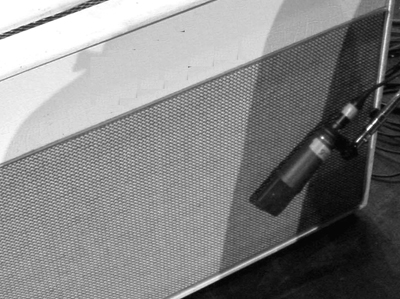
To reduce the number of open mics, turn off any mics not in use at the moment.
You might prefer to turn them down about 12 dB, rather than off, so you don’t miss cues.
Instead of using 10 mics on a drum set, try using a single miniature omni mic in the center of the set.
A mini mic is recommended because it has excellent high-frequency response in all directions -unlike a larger microphone.
Clip the mic to the right side of the snare drum rim, about 4 inches above the drum, and centered in the set. It will pick up the toms and cymbals all around it.
You’ll be amazed how good that single mic can sound. Boost the bass to add fullness. If the cymbals are too weak, lower them a few inches. Hang another mini mic in the kick drum, and it will sound full because omni condenser mics have deep bass response, no matter what their size.
A drawback of this approach is that the balance can’t be controlled among the toms and snare, except with mic placement.
On electric guitar and bass, try using direct boxes instead of mics.
Direct boxes pick up no feedback or leakage, and can be plugged directly into a connector following the musician’s effects boxes.
This method, however, misses the distortion of the guitar amplifier, which is often an essential part of the sound.
Cancel At Distance
Finally, try noise-canceling mics. A noise-canceling (or differential) mic for vocals is designed to cancel sounds at a distance, such as instruments on stage or monitor speakers.
Such a mic provides outstanding gain-before-feedback, and almost total isolation.
The differential mic was designed to cancel sounds beyond a few inches away, such as musical instruments on stage. As a result, many users have reported that their house mix has improved because the mic’s isolation is nearly complete.
In other words, “Mic 1” is no longer vocals and some drums, guitar and bass. “Mic 1” is vocals only.
Singers must use a differential mic with their lips touching the grille; otherwise, their voice gets canceled. This restriction is not a problem because many singers already kiss the mic.
But it can be a drawback if the singer likes to work the mic for effect.
A cardioid differential mic also rejects sound behind the microphone, say, from a floor monitor. Not only does this prevent feedback, it also reduces the sonic coloration caused by monitor sound leaking into the vocal mic.
Give these techniques a try, and you’re likely to find improved results by using one or more of them.
AES and SynAudCon member Bruce Bartlett is the author of “Practical Recording Techniques 5th Edition” and “Recording Music On Location.”

